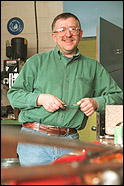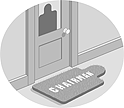Kaleidoscope
Walter Kucharski: A craftsman for outer space
 PHOTO: Owen Egan
PHOTO: Owen Egan |
|
As you're reading this article today, one of Walter Kucharski's creations is on its way to the International Space Station.
Launched this morning from Cape Kennedy in Florida, the shuttle is carrying, in addition to the seven astronauts, numerous experiments, one of which was built by Kucharski. "Hundreds of experiments were proposed for the space station and this is the first Canadian one on human physiology, so we have to look good," says the machinist at McGill's Aerospace Medical Research Unit.
In truth, he's not too worried. This is approximately the 20th experiment in 12 space missions that Kucharski has been involved with, experiments which are paid for by the Canadian Space Agency and destined for NASA flights.
"NASA just loves getting stuff from us because it's so reliable. We've never had a failure in a device. And the crew appreciates the care we take to produce easy-to-execute experiments."
This time round, the experiment is designed to see what happens over time to the H (Hoffman)-reflex under conditions of weightlessness. Measuring the reflex's reactions to an electrical impulse applied behind the knee indicates the degree of spinal cord excitability.
"After 18 hours in the shuttle, they'll do the first experiment," says Kucharski. "After that, they do it periodically over the two days it takes to reach the space station. Then they carry it on board while they will continue to measure the H-reflex over the next six months."
In other words, Kucharski had to build the device so that it would fit equally well within the constrained space of both vessels. Given the design specifications dictated by space, weightlessness, the astronauts' abilities and NASA's stipulations about the types of angles and materials used, Kucharski's task is multifaceted.
He does everything from scrounging for bits of metal -- "Metal dealers sell by the sheet, not by the inch!" -- to building every mechanical component "except the screws and the Velcro."
In Houston, the astronauts test the devices on land, then they are used under conditions of weightlessness on parabolic planes. These old 707 jets -- "the size of two house trailers" -- take up 20 to 30 people to test the equipment to be used in space, explains Kucharski. The plane goes up and down, making the shape of a parabola. As it flies, there's a 30-second period of weightlessness.
Kucharski's been up a few times and is one of the few not to get motion sick. That's a point of embarrassment for physiology professor Douglas Watt, director of the Aerospace Medical Research Unit, who always gets sick.
Watt, perhaps Canada's leading space scientist, Kucharski and engineer Luc Lefebvre comprise "the three musketeers" who conceive the experiments, design the devices and construct them.
As Watt puts it: "After I do the science and Luc does the design, Wally's the one to say we can't do that because it's not practical; he'll turn the theoretical design into practical reality."
It was by accident that Kucharski landed in this highly specialized field. After graduating in the early '70s with a machinist's diploma from Dawson College, he worked a few years in industry as a millwright, but a bad back sent him looking for lighter work in 1979. He stumbled upon the McGill ad in the paper and got the job because he's a generalist.
"Most technical types learn on one type of tool," says Kucharski, standing in his workshop on the 12th floor of the McIntyre Medical Sciences Building, a stunning view of the mountain beyond the imposing lathe and milling machine. "But the hand skills are necessary here because we're always making something different." Given the newness of anything to do with space, every experimental apparatus must be custom made.
Ironically, it's objects from the past that occupy Kucharski's recreational time when he isn't driving his daughter to riding lessons or accompanying his son to the rifle club where Kucharski, a marksman himself, volunteers as a range officer, ensuring everyone's safety.
"My passion is antiques." Antique guns, mostly, that for the past 25 years he has both collected and sold. The oldest in his collection of 30 is a pair of 18th century English sea service pistols.
His personal favourites "are the sporting guns, used by his lordship to pursue his feathered quarry," he says with a smile. "It's the connection to history" that appeals to Kucharski -- "holding something in your hands that goes back 300 years."
 |
||||
|
Why does the government not seem to understand why the emergency rooms are full to bursting... They don't seem to want to put two and two together. It's frightening. |
||||
Little cheer for chairs
 ILLUSTRATION: Tzigane
ILLUSTRATION: Tzigane |
|
What's the worst job at a university? A recent article in The Chronicle of Higher Education made the case for chairs of departments.
According to the Chronicle, chairs' "days are consumed by dealing with recalcitrant faculty members, fighting for resources, shuffling an incredible amount of paperwork, and coping with an ever-expanding array of personal problems that professors and staff members bring to the office." To top it off, their own research interests are generally put on ice.
While chairs do have some authority, such as over hiring and allocating money, the Chronicle argues they have less power than do middle managers in the corporate world. "Although they are responsible to administrators for their department's bottom line, they can't force their faculty members to do anything."
Chairs note that they've had to deal with everything from drug-addicted staff to suicidal students to lecherous professors. "You learn a lot more about your colleagues than you ever wanted to know," says Dennis Baron, the head of the English department at the University of Illinois at Urbana-Champaign.
Not surprisingly, fewer professors are willing to become chairs these days. "I've had to beg faculty members to take on the job," relates Deryl Leaming, a dean at Middle Tennessee State University.
Ed Lazowska, chair of the University of Washington's computer science and engineering department, says leading a group of highly accomplished and highly individualistic professors is no walk in the park. Professors become professors "because they get to do whatever they damn well please. So, how do you forge these people into a team?"
By most accounts, Lazowska has done well. His department recently graduated a Rhodes Scholar and 10 companies have been created by his professors' work. While he says he's enjoyed the job, he makes it no secret that he's anxious to leave it behind; his web site has a countdown that clicks off the seconds until his term expires.
 |
||||
|
If you don't take care of it now, it could be fatal. There's not only loss of life, but also loss of quality of life. |
||||
A DJ's best friend
 Dance club patrons lap up the music from 12-inch vinyl singles
Dance club patrons lap up the music from 12-inch vinyl singles |
|
It was a promotional tool that ended up transforming music.
Communications professor Will Straw is writing a history of the 12-inch vinyl single, created in the mid '70s, in large part, to hype disco songs. A tool for disc jockeys in dance clubs, the singles quickly gained favour among disco fans.
Fans started buying their favourite songs, available in the 12-inch format, instead of buying whole albums since, as Straw puts it, "most disco albums were crap."
As disco waned and made way for house, hip-hop and electronic music, the 12-inch vinyl single remained a cornerstone of the dance clubs that have served as the breeding grounds for new forms of pop music.
The singles are essential for DJs because they lend themselves to playful record mixes and to scratching (physically manipulating the singles while they're playing to create unique sounds from old records) in a way that CDs just can't.
Straw notes that there are plenty of kids who want to "grow up to be a DJ, not a rock star" and that sales for turntables in Britain recently outstripped those for guitars.
"It's become kind of an artisanal industry," Straw says of the people who make, buy and use the singles. "The little record stores on Duluth and St. Laurent that sell [12-inch vinyl singles] are as globally tuned in as HMV is. Maybe more so."
Marshal McLuhan argued that old media forms are used and altered by their successors; Straw says that's pretty much what's happening when a teen rummages through old 12-inch singles at a Salvation Army store looking for good scratching material.
But the singles are on their last legs, he predicts. Few pressing plants make them anymore and new double deck CD players, offering the same mixing and scratching capabilities, are about to hit the marketplace in a big way.

